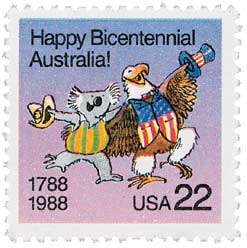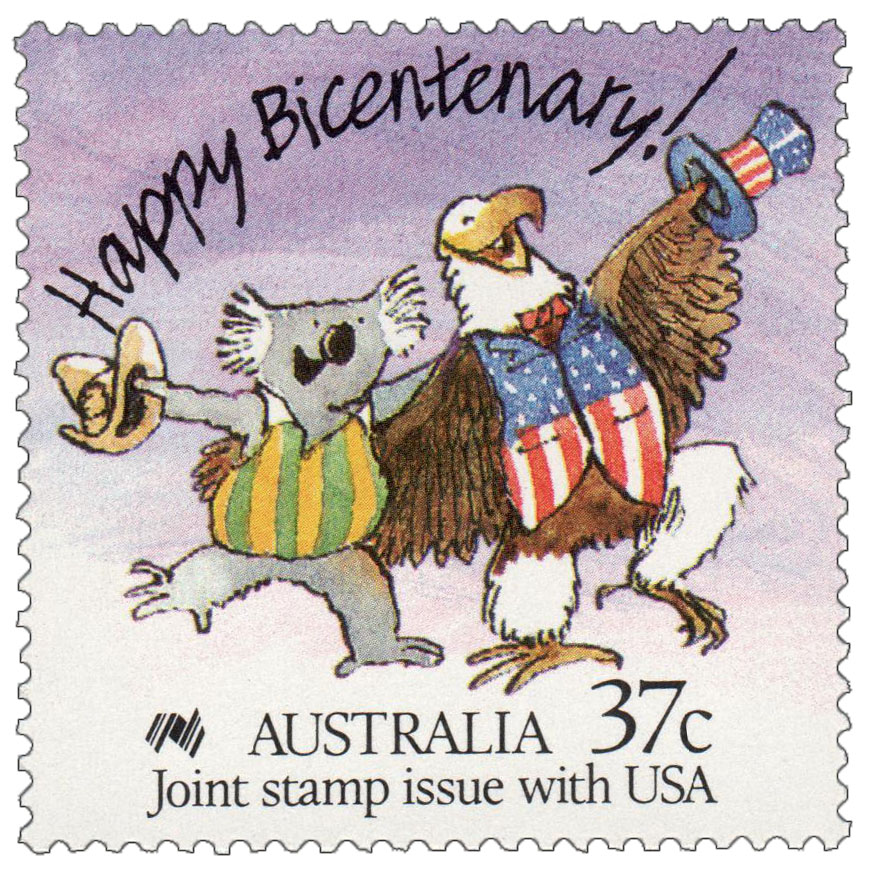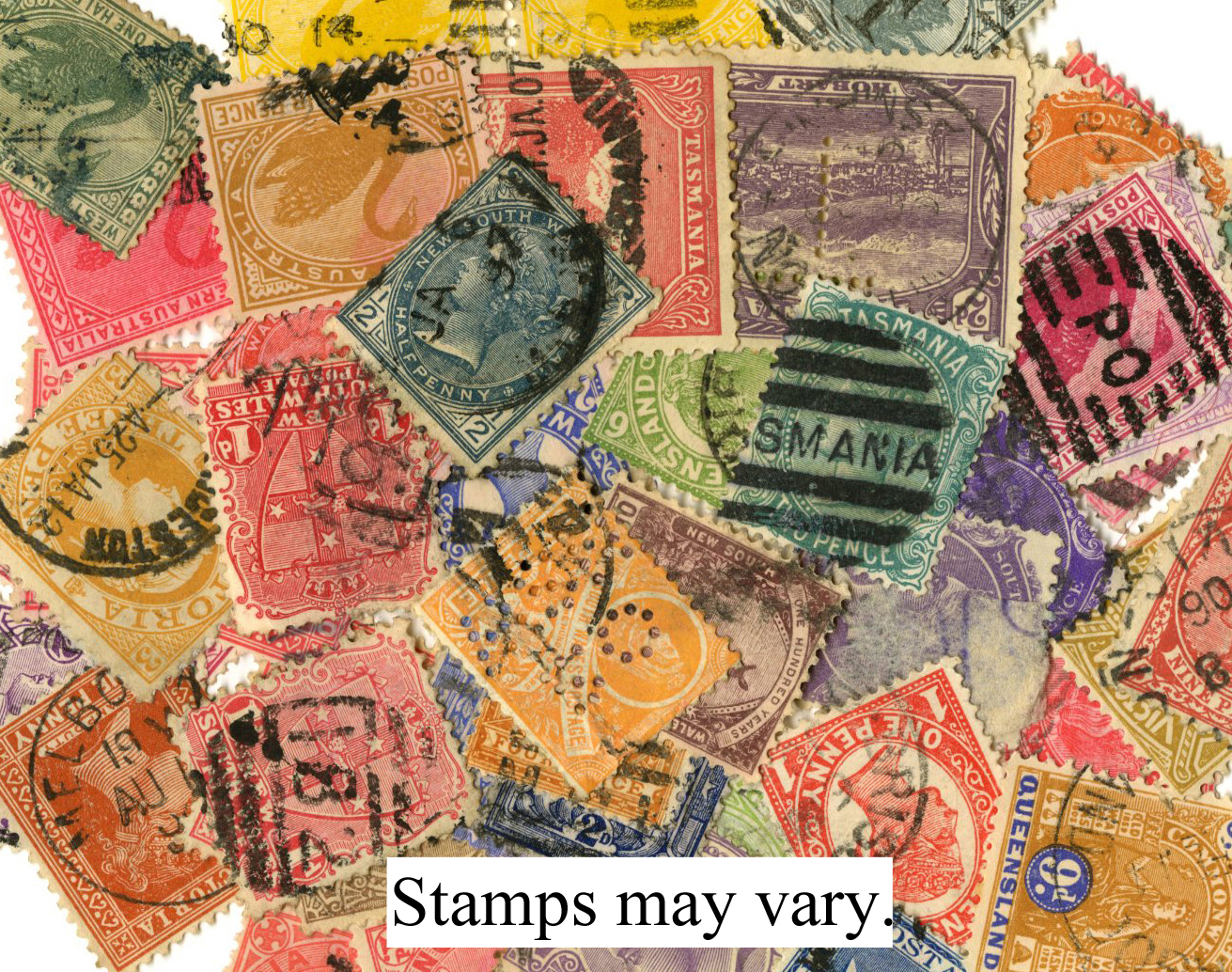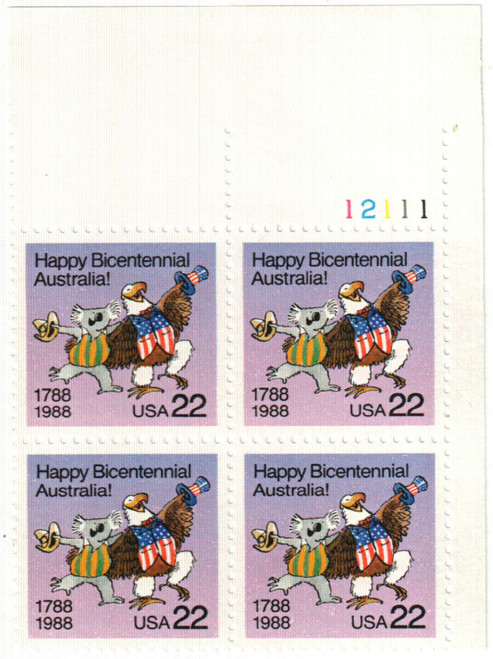
# 2370 PB - 1988 22c Australia Bicentennial
22¢ Australia Bicentennial
City: Washington, DC
Quantity: 145,560,000
Printed By: Bureau of Engraving and Printing
Printing Method: Photogravure
Perforations: 11
Color: Multicolored
Joint Issue: Australia #1052
On January 26, 1788, the first British prisoners arrived in Australia, establishing an experimental penal colony. Though the colony struggled at first, it eventually thrived and became an independent commonwealth. It’s believed the first humans arrived in Australia 50,000 to 65,000 years ago. They traveled by sea from Maritime Southeast Asia, making them some of the world’s first mariners. Early Australian settlers appear to have used fire to clear vegetation, force animals into ambushes, and establish open grasslands. The Aboriginal clans developed trade with visitors from Indonesia and were semi-nomadic. It’s been claimed that Portuguese explorers were the first Europeans to sight Australia in the 1520s, but there is little evidence to support that. Willem Janszoon of the Dutch East India Company is credited as the first documented European to land on Australia in 1606. Also in 1606, Portuguese navigator Pedro Fernandes de Queirós landed on New Hebrides and named the area Austrialia del Espiritu Santo (Southern Land of the Holy Spirit), in honor of Queen Margaret of Austria. In 1644, Abel Tasman named the area New Holland. Dutch explorers made several trips to Australia and made some of the earliest complete maps of its coasts. In 1688, William Dampier was the first British explorer to visit Australia and wrote extensively about the aboriginal people. James Cook landed at Botany Bay in 1770 and claimed possession of the east coast. There had been proposals to colonize Australia as early as 1717. Between 1718 and 1775, the British sent about 50,000 convicts to the New World. After the American Revolution, they lost most of their North American colonies and sought a new place to send their prisoners. As a temporary measure, they created floating prisons, but they quickly reached capacity. And the idea of building more jails in England was considered too expensive. In 1779 and 1783, proposals were submitted to establish penal colonies in New South Wales. They would establish a self-sufficient penal colony that relied on subsistence agriculture. Trade and shipping would be banned, so the convicts would be isolated and not interfere with the British East India Company. The plan was approved and the first settlers arrived at the colony of New South Wales in January 1788. They initially went to Botany Bay, but then moved to Port Jackson, where officially established the first settlement at Sydney Cove on January 26, 1788. This date is celebrated as Australia’s national day, Australia Day. More than 1,000 settlers were part of that first wave, which included 778 convicts, of which 192 were women and 586 were men. Ages ranged from 9 to 82, with sentences of seven to 14 years. The new colony struggled in its early years. Agricultural efforts were largely unsuccessful, and supplies from Britain were scarce. Thousands more settlers arrived in the coming years, but many were sick and incapable of the hard labor required to run the colony. Over time, the colony’s free population grew, made up of emancipated convicts, children born there, soldiers whose service had ended, and even free settlers direct from Britain. By the time the last convict ship arrived in 1868, some 162,000 men and women had been relocated to Australia. Throughout the 1800s, the British established further colonies on the continent. Settlers entered into frequent conflicts with the aboriginals, greatly decreasing their population. With booms brought on by gold rushes and improved agriculture, the colonies prospered and began creating their own parliamentary democracies. On January 1, 1901, the colonies federated to become the Commonwealth of Australia. The Australia Bicentennial Stamps On January 26, 1988, the US and Australia released joint issue stamps honoring Australia’s founding. The stamps feature similar designs of a koala in Australia’s national colors and an eagle in America’s.Australia Day








Item #MP1181 – Get 50 stamps from Australian states.
22¢ Australia Bicentennial
City: Washington, DC
Quantity: 145,560,000
Printed By: Bureau of Engraving and Printing
Printing Method: Photogravure
Perforations: 11
Color: Multicolored
Joint Issue: Australia #1052
On January 26, 1788, the first British prisoners arrived in Australia, establishing an experimental penal colony. Though the colony struggled at first, it eventually thrived and became an independent commonwealth. It’s believed the first humans arrived in Australia 50,000 to 65,000 years ago. They traveled by sea from Maritime Southeast Asia, making them some of the world’s first mariners. Early Australian settlers appear to have used fire to clear vegetation, force animals into ambushes, and establish open grasslands. The Aboriginal clans developed trade with visitors from Indonesia and were semi-nomadic. It’s been claimed that Portuguese explorers were the first Europeans to sight Australia in the 1520s, but there is little evidence to support that. Willem Janszoon of the Dutch East India Company is credited as the first documented European to land on Australia in 1606. Also in 1606, Portuguese navigator Pedro Fernandes de Queirós landed on New Hebrides and named the area Austrialia del Espiritu Santo (Southern Land of the Holy Spirit), in honor of Queen Margaret of Austria. In 1644, Abel Tasman named the area New Holland. Dutch explorers made several trips to Australia and made some of the earliest complete maps of its coasts. In 1688, William Dampier was the first British explorer to visit Australia and wrote extensively about the aboriginal people. James Cook landed at Botany Bay in 1770 and claimed possession of the east coast. There had been proposals to colonize Australia as early as 1717. Between 1718 and 1775, the British sent about 50,000 convicts to the New World. After the American Revolution, they lost most of their North American colonies and sought a new place to send their prisoners. As a temporary measure, they created floating prisons, but they quickly reached capacity. And the idea of building more jails in England was considered too expensive. In 1779 and 1783, proposals were submitted to establish penal colonies in New South Wales. They would establish a self-sufficient penal colony that relied on subsistence agriculture. Trade and shipping would be banned, so the convicts would be isolated and not interfere with the British East India Company. The plan was approved and the first settlers arrived at the colony of New South Wales in January 1788. They initially went to Botany Bay, but then moved to Port Jackson, where officially established the first settlement at Sydney Cove on January 26, 1788. This date is celebrated as Australia’s national day, Australia Day. More than 1,000 settlers were part of that first wave, which included 778 convicts, of which 192 were women and 586 were men. Ages ranged from 9 to 82, with sentences of seven to 14 years. The new colony struggled in its early years. Agricultural efforts were largely unsuccessful, and supplies from Britain were scarce. Thousands more settlers arrived in the coming years, but many were sick and incapable of the hard labor required to run the colony. Over time, the colony’s free population grew, made up of emancipated convicts, children born there, soldiers whose service had ended, and even free settlers direct from Britain. By the time the last convict ship arrived in 1868, some 162,000 men and women had been relocated to Australia. Throughout the 1800s, the British established further colonies on the continent. Settlers entered into frequent conflicts with the aboriginals, greatly decreasing their population. With booms brought on by gold rushes and improved agriculture, the colonies prospered and began creating their own parliamentary democracies. On January 1, 1901, the colonies federated to become the Commonwealth of Australia. The Australia Bicentennial Stamps On January 26, 1988, the US and Australia released joint issue stamps honoring Australia’s founding. The stamps feature similar designs of a koala in Australia’s national colors and an eagle in America’s.Australia Day








Item #MP1181 – Get 50 stamps from Australian states.




